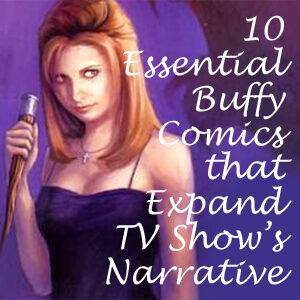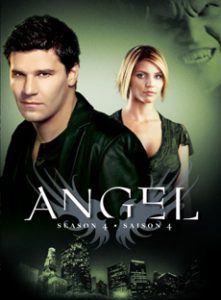“Angel’s” fourth season (2002-03, WB), also known as “The Destruction of Cordelia’s Character,” has the same problems as Seasons 2 and 3: It relies so heavily on one serial thread that when something doesn’t work, it can derail the show for several episodes.
The notable problems are:
- Cordelia, who had ascended to a higher plane, returns to Earth with her memory gone. Then she proceeds to be evil, presumably because she’s being controlled by a bigger Evil. Charisma Carpenter, who I loved in her first six seasons in the Buffyverse, isn’t up to the acting challenge.
- The audience is given no reason to like Connor. On first viewing, I wrote off Vincent Kartheiser as a bad actor. Now I realize that’s not the case (“Mad Men” fans will back that up). The scripts ask him to be a bratty thorn in our hero’s side, and Kartheiser delivers; this is the definition of a thankless role.
- As we follow the Big Bad chain from the Beast to Evil Cordelia to Jasmine (the goddess offspring of Cordelia and Connor), “Angel” is driven by plot, not character, and that’s not a good thing for this show. Furthermore, the villains all seem indestructible, like video game baddies where you have to learn their weak point in order to kill them.

“Angel” Season 4 (2002-03)
WB, 22 episodes
Showrunners: Joss Whedon, David Greenwalt
Stars: David Boreanaz, Charisma Carpenter, Alexis Denisof
On the plus side, Season 4 also has a few cards up its sleeve that it plays wisely:
- “Angel” takes a page from the comic-book world and gives an origin story to Gwen (Alexa Davalos), a sexy electricity-manipulating cross between Elektra and Rogue who is just asking to be made into a six-inch action figure. She gets three episodes, and leaves us wanting more as her love story with Gunn wouldn’t be continued, presumably due to Davalos’ schedule.
- Angelus returns, and David Boreanaz chews up scenery brilliantly.
- Faith returns, and it’s a blast to see Eliza Dushku spend more time in the role that made her a star.
Here are my rankings of the 22 episodes of Season 4, which — thanks to Gwen, Angelus and Faith — I rank as the best of the three seasons in the Hyperion Hotel (but still well behind Seasons 1 and 5):
1. “Orpheus” (episode 15, written by Mere Smith)
There’s a lot to like here. Notably, Angelus and Faith — both knocked out via drugs — take a dream tour through Angel’s past; it’s amusing to see how their reactions differ when they see Angel’s acts of goodness and his lapses. Then Angelus fights Angel, an obvious yet iconic idea.
Meanwhile, Willow drops in to cast the same soul-restoration spell from Season 2 of “Buffy,” yet it doesn’t feel repetitive, in part because of the flirty banter between Willow and Fred (well, Willow is being flirty, Fred’s just being Fred, and that’s why it’s funny).

2. “Awakening” (10, David Fury and Steven S. DeKnight)
Again, a dream state is the key to this episode’s brilliance, but here we don’t realize — unless you’re a particularly keen viewer — that it’s all in Angel’s head until the end. When Angel turned into Angelus on “Buffy,” we saw it from Buffy’s horrified perspective; here we get a sense of what it’s like for Angel.
He experiences several “moments of happiness” — reconciling with Wesley and Connor, and knowing the love of Cordelia. The capper is a welcome nod to Buffy-Angel ‘shippers without offending Angel-Cordy ‘shippers: He gasps “Buffy!” under his breath as his soul fades away, paralleling the previous Angelus arc and affirming that the Slayer is his truest love.
3. “Players” (16, Jeffrey Bell, Sarah Fain and Elizabeth Craft)
In the height of the serialized story, this Gwen-and-Gunn side jaunt is a breath of fresh air. Davalos’ and J. August Richards’ chemistry is electric, and Davalos gives Gwen the perfect mix of deadliness and vulnerability. The plot twists and turns with her character: Is she just using Gunn or does she really like him? In the end, the latter is the case, and it’s a shame that we wouldn’t see Gwen again on TV. (She does pop up in the IDW comics, though.)
4. “Spin the Bottle” (6, Joss Whedon)
Not as great as Whedon’s Season 3 effort, “Waiting in the Wings,” this episode is still a ton of fun as a spell makes everyone revert to their younger selves: Cordy and Wesley become the versions of their characters from “Buffy” (Alexis Denisof, in particular, has fun with pratfalls and awkwardness), Gunn becomes a street tough and Fred is a paranoid pothead (!). Meanwhile, Angel is shocked to learn he’s a vampire; the scene where he morphs back and forth in the bathroom makes me laugh every time.
5. “The House Always Wins” (3, Fury)
The gang breaks free of the hotel in a big way in this Las Vegas-set hour. Now, Sin City holds little appeal for me in real life, but I love visiting Vegas via a TV show. Andy Hallett gets to shine as Lorne, whose dream of making it big isn’t all sunshine and roses. Amy Acker is also funny and (let’s face it) adorable as a Lornette, complete with green-painted skin.
6. “Home” (22, Tim Minear)
Minear, formerly a regular “Angel” writer, disappeared for all of Season 4 until he rescues it in the finale, basically pushing the reset button for Season 5. The gang tours the new Wolfram & Hart building, and although it’s a blatant case of “Angel” showing off the set-builders’ work, it’s such a breath of fresh air from the Jasmine arc that I forgive them. It also finds a way to get rid of Connor via a memory wipe similar to Season 1’s “I Will Remember You”; it’s contrived, but again, I’ll take it.
7. “Salvage” (13, Fury)
Faith returns, and for the next three episodes, “Angel” will become “Faith: The Series” (her arc would then continue on “Buffy”), and I’m not complaining one bit. I like how Faith refuses to kill Angelus, because she owes Angel. And I like how Wesley tests Faith, ironically needing the bad-ass Slayer here, not the softer, redeemed version.
8. “Ground State” (2, Smith)
In introducing Gwen, “Angel” delivers an unabashed “X-Men”-style superhero origin story, something it perhaps should’ve done more often to bolster its roster of action figures … I mean, supporting characters. (A less successful example is Season 1’s “She,” but even that episode is decent.) And it’s nice to see that tables turned with Fred being the jealous, threatened one.
9. “Apocalypse, Nowish” (7, DeKnight)
The downside is that it’s the start of a 16-episode hit-and-miss serial yarn where each episode will pick up where the previous one left off. The upside is that the Beast (basically a big lava monster) looks awesome (again, where’s the action figure?), and the slo-mo fight scene where the gang takes him on with all manner of weaponry — and the Beast rather casually tosses Angel off a tall building — is also pretty darn cool.
10. “Supersymmetry” (5, Craft and Fain)
It gets points for being a Fred-centric episode, and it finds a novel way to break up Gunn and Fred: He kills an evil doctor so she won’t have to, and in episodes to come she’ll ironically shy away from him because of that very action.
11. “Release” (14, DeKnight, Craft and Fain)
The second of the three-part Faith arc features a decent fight scene and Faith’s trick poisoning of Angelus (and herself) that sets the stage for “Orpheus.”
12 and 13. “Soulless” (11, Fain and Craft) and “Calvary” (12, Bell, DeKnight and Smith)
Part of the Angelus arc.
14. “Habeas Corpses” (8, Bell)
“Angel” does zombies, just as “Buffy” had done with Season 2’s “Dead Man’s Party.” The walking dead are overshadowed by the invincible Beast that controls them, though.
15. “Long Day’s Journey” (9, Smith)
Part of the Beast arc.
16. “Slouching Toward Bethlehem” (4, Bell)
Cordelia returns from that white, billowy place in the sky, sans memory.
17. “Deep Down” (1, DeKnight)
It wraps up the annoying cliffhanger from Season 3, and buries the hatchet between Angel and Wesley (who rescues the vampire from the bottom of the ocean). Bad-ass, Lilah-shagging Wes is in fine form in these early Season 4 episodes.
18-22. “Inside Out” (17, DeKnight), “Shiny Happy People” (18, Craft and Fain), “Magic Bullet” (19, Bell), “Sacrifice” (20, Ben Edlund) and “Peace Out” (21, Fury)
And we arrive at the infamous Jasmine arc. Now, I will admit that the concept is daring for a TV show: Everyone is under the thrall of a god who makes them utterly content. The downside is that Jasmine eats a couple dozen people a day to maintain her power.
The arc raises compelling metaphorical questions about religion, political power and free will (and admittedly, the occasional glimpse of Jasmine’s true face, covered in maggots, is creepy), yet I still had forgotten all the details of these episodes from my initial viewing. (The fact that Jasmine is played by Gina Torres from the freshly canceled “Firefly” may have distracted me.) Furthermore, this arc is illogically epic: If Jasmine has taken over the entire state of California, how come Sunnydale is unaffected over on “Buffy” Season 7?
How would you rank the 22 episodes of “Angel’s” fourth season? I’ll be back soon with a look at the outstanding Season 5, when the gang sets up shop at Wolfram & Hart, Spike comes over from “Buffy” to join them, and the show refreshingly returns to its standalone roots.
Click here for an index of all of John’s “Buffy” and “Angel” reviews.

